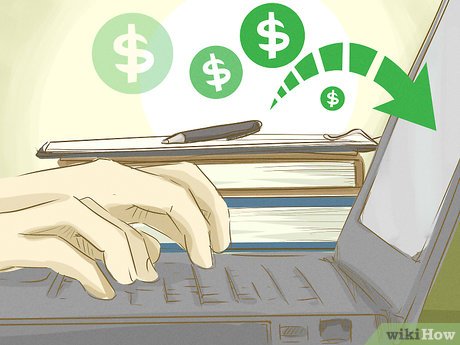How to Use a Stop Limit
Setting Your Stop Price
-
 Evaluate projections for the stock's value. Whether you're thinking about buying or selling a stock, you need to know what's going on with that stock and how its value is trending. Read reports about the financial health of the company as well as the company's sector.[2]
Evaluate projections for the stock's value. Whether you're thinking about buying or selling a stock, you need to know what's going on with that stock and how its value is trending. Read reports about the financial health of the company as well as the company's sector.[2]- Look at the background and history of the company and its executives as well. Turnover in a corporation's C-suite can dramatically impact the price of stock.
- The overall economy also plays a role in what's going to happen to a stock's price.
- Determine what amount of loss you're comfortable with. If you're using your stop-limit order to sell stock, the easiest way to set a stop is to put it at a percentage below the price at which you bought the stock. The percentage you choose depends on your own personal comfort level, but most investors set a stop between 5% and 15% below their purchase price.[3]
- The percentage you choose also depends on how heavily invested you are in a particular stock. If a single stock makes up 25% of your portfolio, for example, you would probably want to set your stop at 5% below the purchase price so you don't take as big of a hit.
- The performance of other stocks in your portfolio is also a consideration. For example, if you had huge gains in one stock, you might be comfortable with a larger loss in another stock.
- Find the stock's recent levels of support and resistance. Looking at a stock chart, you can draw straight lines at the top and bottom of the zig-zag line that shows the stock's pattern of rises and falls. The bottom line is the stock's "support" — the price level the stock doesn't seem to fall below. The top line is the stock's "resistance — the price level the stock doesn't seem to rise above. While the actual value of the stock may fluctuate, it tends to stay between these two levels.[4]
- If you're placing a sell order, you would place it just below the stock's most recent level of support. If the stock goes below this level, that normally means it will continue to lose value for some time before it rebounds, so you can control your losses.
- If you're placing a buy order, you would place your stop just above the stock's most recent level of resistance if you're trying to protect upside risk. If the stock's price breaks this barrier, it will typically continue that upward trend, so you want more stock to see greater earnings.
- Avoid placing your stop at a round number. Many investors place stops at round numbers, such as 10, 50, or 100. While you have no way of knowing exactly where other investors have placed stops, using odd numbers helps you avoid having the order execute just before the stock moves in the direction you actually want it to.[5]
- If there are a lot of stops at a particular number, your order might not be executed until the stock has already turned around and hit the stop on the way back. This is particularly likely to happen in a volatile market or with a volatile stock.
- To avoid this phenomenon, try placing your stock on an odd or uncommon number. For example, if you think a lot of investors have put a stop at 50, you might put your stop at 49.75 instead.
Warning: Your stop price is not a guaranteed execution price. If the stock moves quickly, your broker may not have time to act before the stop price has passed.
Choosing Your Limit Price
-
 Look at the market history for the stock. The stock's price history, particularly in the previous few months, gives you a better idea of what a reasonable limit price might be. You don't want to set a limit that's either so high or so low that it may never be met.[6]
Look at the market history for the stock. The stock's price history, particularly in the previous few months, gives you a better idea of what a reasonable limit price might be. You don't want to set a limit that's either so high or so low that it may never be met.[6]- For example, if you're setting a sell limit for a stock that has not gone below $20 in the past 6 months, it would make more sense to set your limit at $21 than at $15.
- Likewise, if you're setting a buy limit for a stock that hasn't gone above $50 in the past 6 months, you'd probably want to set your buy limit around or under $50.
- Predict the future value of the stock. Since your order is going to be executed at some point in the future, you need to be able to tell which direction the stock's price is headed and where it will likely end up. Stock charts show you the trend in stock prices over a period of several months.[7]
- Look at the trend to determine if the stock is trending up or down. From there, you can determine where to reasonably set your limits.
- Overall market conditions are also important to consider when making your predictions. If the market is currently entering a recession, for example, a buy stop-limit order with a stop over the stock's level of resistance might never be executed.
- Analyze the other investments in your portfolio. A stop-limit order gives you more control over your portfolio so you can determine the price at which you'll buy or sell stock. Looking at how the rest of your portfolio is doing will give you a better idea of what price would be best for your overall investments.[8]
- For example, if the majority of the stocks in your portfolio are performing relatively well and are fairly conservative investments given the current market conditions, you might be able to stomach a little more risk.
- On the other hand, if the majority of the stocks in your portfolio are performing poorly, you would want to set a higher limit price on a sell stop-limit order to control your losses as much as possible.
- Decide how quickly you want your order to be filled. Where you set your limit can determine how quickly your order is filled, particularly if there is a significant difference between your stop price and your limit price. If you want your order to be filled quickly, keep your limit price within a range that seems reasonable for the stock after it hits your stop price.[9]
- Since your broker will sell your stock at your limit price or better, you would set your limit for the absolute least amount you're willing to take per share of the stock. For example, if you set your stop price for a sell stop-limit order at $21.75, you might set your limit at $20.
Warning: Your limit price might actually prevent your order from being executed, particularly if the stock price fluctuates rapidly.
Placing Your Order
-
 Transfer cash funds to your investment account if necessary. If you're placing a buy order, you'll generally need to have enough cash in your investment account to cover the order when it's placed. For a sell order, on the other hand, your broker may not require you to have a specific cash balance on hand.[10]
Transfer cash funds to your investment account if necessary. If you're placing a buy order, you'll generally need to have enough cash in your investment account to cover the order when it's placed. For a sell order, on the other hand, your broker may not require you to have a specific cash balance on hand.[10]- If you have a margin account, you may not need to transfer cash into your account to cover the order. With a margin account, you can borrow money from the broker to make trades.[11]
- Choose the type of trade and stock you want to trade. On your online trading platform, select either a buy or a sell, depending on what type of trade you want to make. Then enter the name or ticker symbol of the stock you want to trade.[12]
- Make sure you've selected that you want to make a "stop-limit" trade. This will bring up the spaces for you to provide the conditions of your order.
- Add your stop and limit prices. Set the stop and limit at the prices you've chosen based on your research and analysis. You might have additional information to provide, depending on your broker's standards for stop-limit orders.[13]
- Your stop price and your limit price don't have to be the same amount, although they can be. Your order is less likely to be filled if there's a significant difference between the two prices.
- Indicate how long you want the order to be open. Most brokers give you a choice of duration on a stop-limit order. You can set it as short as a day, meaning if the conditions of the order aren't met by the end of the day, your order will expire.[14]
- If you set a standing order, it will remain in place until that stock reaches your stop price and triggers the order. If it isn't executed, it remains until the next time the stock reaches your stop price.
- You can typically also set orders for any duration in between a day order and a standing order. For example, you might set a stop-limit order for 3 months. If the order is not executed during the duration you set, it expires and simply goes away.
Tip: Regardless of the duration you set, you can usually renew your order before it expires. Your renewal will be for the same duration as the original order.
- Submit your order to your broker. Look over your order carefully to make sure all the information is correct and in the right place before you submit your order. After you've submitted, it can be difficult to correct errors.[15]
- Typically, your broker will send you a confirmation of your order. Look over the confirmation carefully and make sure everything in it is correct. Retain the confirmation in your records.
-
 Continue to watch the market carefully. When you place a stop-limit order, your broker will automatically attempt to execute it once your conditions are met. However, this doesn't mean that you can just sit back and do nothing. You still have to pay attention to the market to make sure your stop-limit order remains relevant. Look in particular for sudden movement in the stock in the opposite direction of the one predicted by your stop-limit order.[16]
Continue to watch the market carefully. When you place a stop-limit order, your broker will automatically attempt to execute it once your conditions are met. However, this doesn't mean that you can just sit back and do nothing. You still have to pay attention to the market to make sure your stop-limit order remains relevant. Look in particular for sudden movement in the stock in the opposite direction of the one predicted by your stop-limit order.[16]- For example, suppose you placed a sell stop-limit order when a particular stock was performing poorly and seemed to be on a downward trend. However, the stock has rebounded. Since it seems unlikely the order will meet your stop, you might want to cancel your order or adjust the stop upward to further minimize your risk of loss.
5 ★ | 1 Vote
You should read it
- Admire the award-winning works in the first stock photography contest about hackers
- Russian stock market staggered because of the virus
- Keep track of the stock market with Google Sheets
- The best 5 free stock market monitoring apps for Android and iOS
- 5 ways to use the scanner effectively
- Want to find Stock stock images for free? Do not ignore these websites!
- How to fix STOP error 0x0000008E
- How to fix STOP 0x00000004 in Windows
May be interested
- How to limit download speed of IDM
 speaking of speeding up downloads, everyone knows internet download manager (idm). this is the most famous and most popular download support application in the world today. however, sometimes not everything is perfect, for example, if it takes up the entire bandwidth if you don't have reasonable adjustments.
speaking of speeding up downloads, everyone knows internet download manager (idm). this is the most famous and most popular download support application in the world today. however, sometimes not everything is perfect, for example, if it takes up the entire bandwidth if you don't have reasonable adjustments. - How to Turn Off Headphone Volume Limit Warning on iPhone
 iphone has a speaker volume limit setting to control the sound. however, in some situations you need to increase the volume on your iphone to be able to hear the content.
iphone has a speaker volume limit setting to control the sound. however, in some situations you need to increase the volume on your iphone to be able to hear the content. - Tips to limit game time, limit application time on Windows 10
 limit time to play games, use applications on windows 10 to help parents better manage their children. with this management feature, you will never have to worry about children playing games, forgetting to study, playing games when their parents are not at home.
limit time to play games, use applications on windows 10 to help parents better manage their children. with this management feature, you will never have to worry about children playing games, forgetting to study, playing games when their parents are not at home. - Why do babies rub their eyes?
 eye rubbing is a sign that your child is anxious or feeling insecure and needs to be stopped to avoid injury. here's what you need to know about your child's eye rubbing behavior.
eye rubbing is a sign that your child is anxious or feeling insecure and needs to be stopped to avoid injury. here's what you need to know about your child's eye rubbing behavior. - How to Use Limit Breaker in Anime Adventures
 with the limit break option, you can easily maximize the potential of your best units in anime adventures. here's how to use limit breakers in anime adventures.
with the limit break option, you can easily maximize the potential of your best units in anime adventures. here's how to use limit breakers in anime adventures. - Instructions for limiting iPhone speaker volume
 ios 18.2 brings an option to limit iphone speaker volume. users can adjust how loud their iphone speakers can play songs, videos, and other media.
ios 18.2 brings an option to limit iphone speaker volume. users can adjust how loud their iphone speakers can play songs, videos, and other media. - The time-limited feature on Apple's iOS 12 is hacked by a 7-year-old child
 a parent shared on the reddit forum that his 7-year-old son has successfully hacked the time limit for using apple apps.
a parent shared on the reddit forum that his 7-year-old son has successfully hacked the time limit for using apple apps. - STOP - Ransomware is the most active in the Internet but rarely talked about
 the fight against stop ransomware in particular and other ransomware strains in general is still very difficult and no appointment of an end date.
the fight against stop ransomware in particular and other ransomware strains in general is still very difficult and no appointment of an end date. - How to remove the 40 minute limit on Zoom for unlimited use
 zoom has a policy to support teachers by removing the 40-minute limit when they log in zoom by email with the domain @ edu.vn. this article will guide teachers to remove the 40 minute limit on zoom so that they can teach unlimited on zoom.
zoom has a policy to support teachers by removing the 40-minute limit when they log in zoom by email with the domain @ edu.vn. this article will guide teachers to remove the 40 minute limit on zoom so that they can teach unlimited on zoom. - 5 Tweaks to Stop Your Smart TV from Tracking You
 if your smart tv could talk, it would give away all your viewing secrets. luckily, you can stop it from revealing what you're watching at 2 a.m. to everyone.
if your smart tv could talk, it would give away all your viewing secrets. luckily, you can stop it from revealing what you're watching at 2 a.m. to everyone.














 How to Teach K‐12 Students Remotely
How to Teach K‐12 Students Remotely How to Create Your Ideal Relationship
How to Create Your Ideal Relationship How to Make Your Illustrations Look Professional
How to Make Your Illustrations Look Professional How to Become a Teacher of Hearing Impaired Students
How to Become a Teacher of Hearing Impaired Students How to Use a Period in Writing
How to Use a Period in Writing How to Shop During Coronavirus
How to Shop During Coronavirus